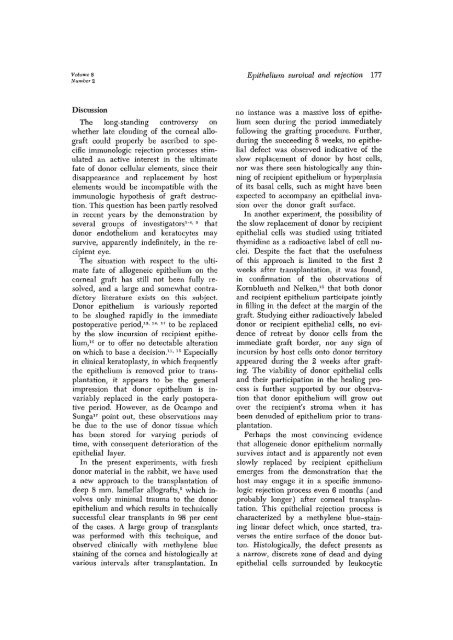The survival and rejection of epithelium in experimental corneal ...
The survival and rejection of epithelium in experimental corneal ...
The survival and rejection of epithelium in experimental corneal ...
Create successful ePaper yourself
Turn your PDF publications into a flip-book with our unique Google optimized e-Paper software.
Volume 8<br />
Number 2<br />
Epithelium <strong>survival</strong> <strong>and</strong> <strong>rejection</strong> 177<br />
Discussion<br />
<strong>The</strong> long-st<strong>and</strong><strong>in</strong>g controversy on<br />
whether late cloud<strong>in</strong>g <strong>of</strong> the <strong>corneal</strong> allograft<br />
could properly be ascribed to specific<br />
immunologic <strong>rejection</strong> processes stimulated<br />
an active <strong>in</strong>terest <strong>in</strong> the ultimate<br />
fate <strong>of</strong> donor cellular elements, s<strong>in</strong>ce their<br />
disappearance <strong>and</strong> replacement by host<br />
elements would be <strong>in</strong>compatible with the<br />
immunologic hypothesis <strong>of</strong> graft destruction.<br />
This question has been partly resolved<br />
<strong>in</strong> recent years by the demonstration by<br />
several groups <strong>of</strong> <strong>in</strong>vestigators 1 ''• 9 that<br />
donor endothelium <strong>and</strong> keratocytes may<br />
survive, apparently <strong>in</strong>def<strong>in</strong>itely, <strong>in</strong> the recipient<br />
eye.<br />
<strong>The</strong> situation with respect to the ultimate<br />
fate <strong>of</strong> allogeneic <strong>epithelium</strong> on the<br />
<strong>corneal</strong> graft has still not been fully resolved,<br />
<strong>and</strong> a large <strong>and</strong> somewhat contradictory<br />
literature exists on this subject.<br />
Donor <strong>epithelium</strong> is variously reported<br />
to be sloughed rapidly <strong>in</strong> the immediate<br />
postoperative period, 13 ' 14> 17 to be replaced<br />
by the slow <strong>in</strong>cursion <strong>of</strong> recipient <strong>epithelium</strong>,<br />
10 or to <strong>of</strong>fer no detectable alteration<br />
on which to base a decision. 11 ' 15 Especially<br />
<strong>in</strong> cl<strong>in</strong>ical keratoplasty, <strong>in</strong> which frequently<br />
the <strong>epithelium</strong> is removed prior to transplantation,<br />
it appears to be the general<br />
impression that donor <strong>epithelium</strong> is <strong>in</strong>variably<br />
replaced <strong>in</strong> the early postoperative<br />
period. However, as de Ocampo <strong>and</strong><br />
Sunga 17 po<strong>in</strong>t out, these observations may<br />
be due to the use <strong>of</strong> donor tissue which<br />
has been stored for vary<strong>in</strong>g periods <strong>of</strong><br />
time, with consequent deterioration <strong>of</strong> the<br />
epithelial layer.<br />
In the present experiments, with fresh<br />
donor material <strong>in</strong> the rabbit, we have used<br />
a new approach to the transplantation <strong>of</strong><br />
deep 8 mm. lamellar allografts, 5 which <strong>in</strong>volves<br />
only m<strong>in</strong>imal trauma to the donor<br />
<strong>epithelium</strong> <strong>and</strong> which results <strong>in</strong> technically<br />
successful clear transplants <strong>in</strong> 98 per cent<br />
<strong>of</strong> the cases. A large group <strong>of</strong> transplants<br />
was performed with this technique, <strong>and</strong><br />
observed cl<strong>in</strong>ically with methylene blue<br />
sta<strong>in</strong><strong>in</strong>g <strong>of</strong> the cornea <strong>and</strong> histologically at<br />
various <strong>in</strong>tervals after transplantation. In<br />
no <strong>in</strong>stance was a massive loss <strong>of</strong> <strong>epithelium</strong><br />
seen dur<strong>in</strong>g the period immediately<br />
follow<strong>in</strong>g the graft<strong>in</strong>g procedure. Further,<br />
dur<strong>in</strong>g the succeed<strong>in</strong>g 8 weeks, no epithelial<br />
defect was observed <strong>in</strong>dicative <strong>of</strong> the<br />
slow replacement <strong>of</strong> donor by host cells,<br />
nor was there seen histologically any th<strong>in</strong>n<strong>in</strong>g<br />
<strong>of</strong> recipient <strong>epithelium</strong> or hyperplasia<br />
<strong>of</strong> its basal cells, such as might have been<br />
expected to accompany an epithelial <strong>in</strong>vasion<br />
over the donor graft surface.<br />
In another experiment, the possibility <strong>of</strong><br />
the slow replacement <strong>of</strong> donor by recipient<br />
epithelial cells was studied us<strong>in</strong>g tritiated<br />
thymid<strong>in</strong>e as a radioactive label <strong>of</strong> cell nuclei.<br />
Despite the fact that the usefulness<br />
<strong>of</strong> this approach is limited to the first 2<br />
weeks after transplantation, it was found,<br />
<strong>in</strong> confirmation <strong>of</strong> the observations <strong>of</strong><br />
Kornblueth <strong>and</strong> Nelken, 15 that both donor<br />
<strong>and</strong> recipient <strong>epithelium</strong> participate jo<strong>in</strong>tly<br />
<strong>in</strong> fill<strong>in</strong>g <strong>in</strong> the defect at the marg<strong>in</strong> <strong>of</strong> the<br />
graft. Study<strong>in</strong>g either radioactively labeled<br />
donor or recipient epithelial cells, no evidence<br />
<strong>of</strong> retreat by donor cells from the<br />
immediate graft border, nor any sign <strong>of</strong><br />
<strong>in</strong>cursion by host cells onto donor territory<br />
appeared dur<strong>in</strong>g the 2 weeks after graft<strong>in</strong>g.<br />
<strong>The</strong> viability <strong>of</strong> donor epithelial cells<br />
<strong>and</strong> their participation <strong>in</strong> the heal<strong>in</strong>g process<br />
is further supported by our observation<br />
that donor <strong>epithelium</strong> will grow out<br />
over the recipient's stroma when it has<br />
been denuded <strong>of</strong> <strong>epithelium</strong> prior to transplantation.<br />
Perhaps the most conv<strong>in</strong>c<strong>in</strong>g evidence<br />
that allogeneic donor <strong>epithelium</strong> normally<br />
survives <strong>in</strong>tact <strong>and</strong> is apparently not even<br />
slowly replaced by recipient <strong>epithelium</strong><br />
emerges from the demonstration that the<br />
host may engage it <strong>in</strong> a specific immunologic<br />
<strong>rejection</strong> process even 6 months (<strong>and</strong><br />
probably longer) after <strong>corneal</strong> transplantation.<br />
This epithelial <strong>rejection</strong> process is<br />
characterized by a methylene blue-sta<strong>in</strong><strong>in</strong>g<br />
l<strong>in</strong>ear defect which, once started, traverses<br />
the entire surface <strong>of</strong> the donor button.<br />
Histologically, the defect presents as<br />
a narrow, discrete zone <strong>of</strong> dead <strong>and</strong> dy<strong>in</strong>g<br />
epithelial cells surrounded by leukocytic
















